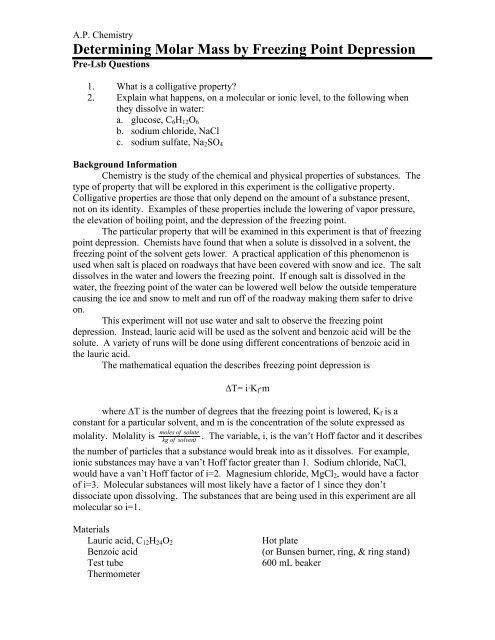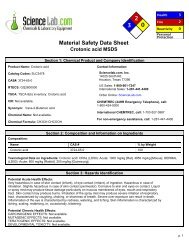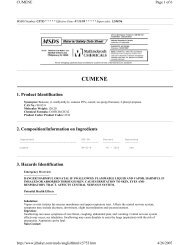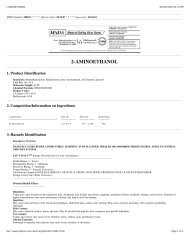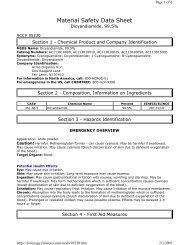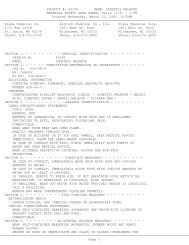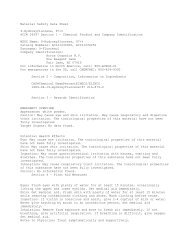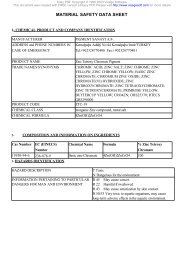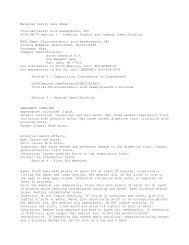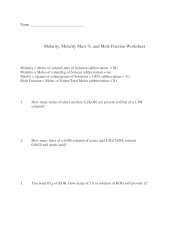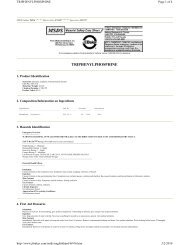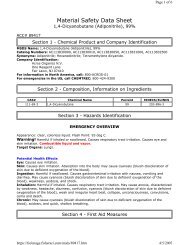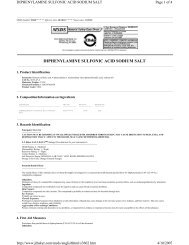Determining Molar Mass by Freezing Point Depression
Determining Molar Mass by Freezing Point Depression
Determining Molar Mass by Freezing Point Depression
Create successful ePaper yourself
Turn your PDF publications into a flip-book with our unique Google optimized e-Paper software.
A.P. Chemistry<strong>Determining</strong> <strong>Molar</strong> <strong>Mass</strong> <strong>by</strong> <strong>Freezing</strong> <strong>Point</strong> <strong>Depression</strong>Pre-Lsb Questions1. What is a colligative property?2. Explain what happens, on a molecular or ionic level, to the following whenthey dissolve in water:a. glucose, C 6 H 12 O 6b. sodium chloride, NaClc. sodium sulfate, Na 2 SO 4Background InformationChemistry is the study of the chemical and physical properties of substances. Thetype of property that will be explored in this experiment is the colligative property.Colligative properties are those that only depend on the amount of a substance present,not on its identity. Examples of these properties include the lowering of vapor pressure,the elevation of boiling point, and the depression of the freezing point.The particular property that will be examined in this experiment is that of freezingpoint depression. Chemists have found that when a solute is dissolved in a solvent, thefreezing point of the solvent gets lower. A practical application of this phenomenon isused when salt is placed on roadways that have been covered with snow and ice. The saltdissolves in the water and lowers the freezing point. If enough salt is dissolved in thewater, the freezing point of the water can be lowered well below the outside temperaturecausing the ice and snow to melt and run off of the roadway making them safer to driveon.This experiment will not use water and salt to observe the freezing pointdepression. Instead, lauric acid will be used as the solvent and benzoic acid will be thesolute. A variety of runs will be done using different concentrations of benzoic acid inthe lauric acid.The mathematical equation the describes freezing point depression is∆T= i·K f·mwhere ∆T is the number of degrees that the freezing point is lowered, K f is aconstant for a particular solvent, and m is the concentration of the solute expressed asmoles of solutemolality. Molality is . The variable, i, is the van’t Hoff factor and it describeskg of solventthe number of particles that a substance would break into as it dissolves. For example,ionic substances may have a van’t Hoff factor greater than 1. Sodium chloride, NaCl,would have a van’t Hoff factor of i=2. Magnesium chloride, MgCl 2 , would have a factorof i=3. Molecular substances will most likely have a factor of 1 since they don’tdissociate upon dissolving. The substances that are being used in this experiment are allmolecular so i=1.MaterialsLauric acid, C 12 H 24 O 2Benzoic acidTest tubeThermometerHot plate(or Bunsen burner, ring, & ring stand)600 mL beaker
A.P. Chemistry<strong>Determining</strong> <strong>Molar</strong> <strong>Mass</strong> <strong>by</strong> <strong>Freezing</strong> <strong>Point</strong> <strong>Depression</strong>Procedure1. Put on your lab apron and goggles.2. Weigh out 10 g of solid lauric acid.Determination of the melting point of pure lauric acid.3. Place the lauric acid in to the test tube.4. Fill 600 mL beaker about ¾ full with tap water.5. Place beaker with water on hot plate and start heating water.6. Place test tube in beaker and heat until the lauric acid is completely melted(be sure to stir the lauric acid carefully with the thermometer)7. Once the lauric acid is completely melted, carefully remove the lauric acidfrom the hot water and allow it to cool. Keep the beaker of water warm forlater trials.8. Record the temperature every 30 seconds until the temperature reachesapproximately 35°C.Determination of the freezing point of lauric acid/benzoic acid mixture9. Weigh out 10 g of solid lauric acid.10. Place the lauric acid in to the test tube.11. Weigh out 1.0 g of benzoic acid and place into the test tube with the lauricacid.12. Using the hot water from the trial with pure lauric acid.13. Place test tube in beaker and heat until the lauric acid/benzoic acid mixture iscompletely melted (be sure to stir the lauric acid carefully with thethermometer)14. Once the mixture is completely melted, carefully remove it from the hotwater and allow it to cool.15. Record the temperature every 30 seconds until the temperature reachesapproximately 25°C.16. Repeat steps 9 through 15 two more times increasing the amount benzoic acid<strong>by</strong> 1.0 g each time.
A.P. Chemistry<strong>Determining</strong> <strong>Molar</strong> <strong>Mass</strong> <strong>by</strong> <strong>Freezing</strong> <strong>Point</strong> <strong>Depression</strong> – Lab ReportDataTemperaturesTimeTrial 1(10.0 g lauric acid)Trial 2(10.0 g lauric acid +1.0 g benzoic acid)Trial 3(10.0 g lauric acid +2.0 g benzoic acid):301:001:302:002:303:003:304:004:305:005:306:006:307:007:30This data table will probably have to be extended to fit all of the temperaturereadings that will be takenTrial 4(10.0 g lauric acid +3.0 g benzoic acid)Analysis1. Graph the temperature data with temperature on the y-axis and time on the x-axis. If done carefully, all three sets of data can be plotted on the same graphin different colors. Attach graph(s) to back of lab report page.2. Determine the freezing point for each trial.Trial 1 _________________ °C Trial 3 ______________ °CTrial 2 _________________ °C Trial 4 ______________ °C3. Determine the ∆T f for each Trial.Trial 1: ∆T f = 0 °C Trial 3: ∆T f =___________ °CTrial 2: ∆T f =____________ °C Trial 4: ∆T f =___________ °C
A.P. Chemistry<strong>Determining</strong> <strong>Molar</strong> <strong>Mass</strong> <strong>by</strong> <strong>Freezing</strong> <strong>Point</strong> <strong>Depression</strong> – Lab Report°C⋅kg4. The K f for lauric acid is 3.90 mol. Use this information, along with the datathat has been accumulated in this lab to calculate the molality of each solution.Trial 1: N/A m Trial 3: _________ mTrial 2: ___________ mTrial 4: _________ m5. Molality is calculated as followsmolality =moles of solutekg of solventUsing this equation and the rest of the data collected during this lab, calculatethe molar mass of benzoic acid from each trial and average them together.Report the average molar mass that was calculated.Conclusion1. Look up the molecular mass of benzoic acid and compare it with theexperimental value. Calculate the percent error in the experimental molarmass.2. Give a possible explanation that accounts for the error.3. If the benzoic acid were a strong acid that completely dissociated in waterforming H + ions and benzoate ions, what would have been the effect on thefreezing point. Give both a quantitative and qualitative response.
A.P. Chemistry<strong>Determining</strong> <strong>Molar</strong> <strong>Mass</strong> <strong>by</strong> <strong>Freezing</strong> <strong>Point</strong> <strong>Depression</strong> – Instructor VersionDataTemperaturesTime(5 points for completing pre-lab questions)(10 points for participating in lab, collecting data, and completing data tables)Trial 1(10.0 g lauric acid)Trial 2(10.0 g lauric acid +1.0 g benzoic acid)Trial 3(10.0 g lauric acid +2.0 g benzoic acid)Trial 4(10.0 g lauric acid +3.0 g benzoic acid):30 70.4 71.2 69.4 80.01:00 65.3 66.1 65.0 76.21:30 60.8 61.6 59.7 71.52:00 56.1 55.9 54.6 66.32:30 51.2 50.8 49.8 61.73:00 48.3 47.5 45.7 54.83:30 45.2 43.3 41.3 49.24:00 44.1 42.1 39.9 45.34:30 44.5 40.5 38.5 40.85:00 44.4 41.3 37.5 35.85:30 44.2 41.3 38.1 34.06:00 44.3 41.1 37.9 34.96:30 44.2 40.9 37.7 34.57:00 44.1 40.5 36.9 33.27:30 44.0 40.2 35.8 32.18:00 43.9 39.8 34.5 30.98:30 43.9 39.1 33.2 29.59:00 43.8 38.4 32.0 28.19:30 43.5 37.1 30.7 26.510:00 42.1 36.2 29.1 24.910:30 40.2 34.7 27.5 23.111:00 37.1 32.1 26.2 21.011:30 32.9 29.9 24.612:00 27.4 23.112:30 25.3 20.913:00 22.7
A.P. Chemistry<strong>Determining</strong> <strong>Molar</strong> <strong>Mass</strong> <strong>by</strong> <strong>Freezing</strong> <strong>Point</strong> <strong>Depression</strong> – Instructor VersionAnalysis1. Graph the temperature data with temperature on the y-axis and time on the x-axis. If done carefully, all three sets of data can be plotted on the same graphin different colors. Attach graph(s) to back of lab report page. (4 points)90.080.070.060.050.040.030.020.010.00.00 5 10 15 20 25 30 35Series1Series2Series3Series42. Determine the freezing point for each trial. (4 points)Trial 1 44.5 °C Trial 3 38.1 °CTrial 2 41.3 °C Trial 4 34.9 °C3. Determine the ∆T f for each Trial. (3 points)Trial 1: ∆T f = 0 °C Trial 3: ∆T f = 6.4 °CTrial 2: ∆T f = 3.2 °C Trial 4: ∆T f = 9.6 °C°C⋅kg4. The K f for lauric acid is 3.90 mol. Use this information, along with the datathat has been accumulated in this lab to calculate the molality of each solution.(3 points)Trial 1: N/A m Trial 3: 1.64 mTrial 2: 0.819 m Trial 4: 2.46 m
A.P. Chemistry<strong>Determining</strong> <strong>Molar</strong> <strong>Mass</strong> <strong>by</strong> <strong>Freezing</strong> <strong>Point</strong> <strong>Depression</strong> – Instructor Version5. Molality is calculated as followsmolality =moles of solutekg of solventUsing this equation and the rest of the data collected during this lab, calculatethe molar mass of benzoic acid from each trial and average them together.Report the average molar mass that was calculated. (4 points)0.819m =molar mass ofmoles ofmolarmass = 122.1Benzoic acid0.010 kg Lauric acidbenzoic acid =gmolso...grams ofmoles ofmoles ofbenzoic acidbenzoic acidBenzoic acid = 0.00819 mol1.0 g benzoic acidso... molar mass =0.00819 molesThe other trials are calculated in the same manner and then the results are averaged. The actualgmolar mass of Benzoic acid is 122.12 mol .Conclusion1. Look up the molecular mass of benzoic acid and compare it with theexperimental value. Calculate the percent error in the experimental molarmass. (2 points)122.12 − 122.1% error = × 100 = 0.016%122.122. Give a possible explanation that accounts for the error. (1 point)Possible sources of error include the scientific error involved in reading the scales,thermometers. Students may also include other sources of human error.3. If the benzoic acid were a strong acid that completely dissociated in waterforming H + ions and benzoate ions, what would have been the effect on thefreezing point. Give both a quantitative and qualitative response. (3 points)If benzoic acid were an ionic substance so that it would completely dissociate upon dissolvingin water, then the freezing point depression effect would be doubled because of the numberparticles in solution would be doubled. So the freezing point in trial one would actually be38.1°C. The ∆T for the other trials would also be doubled.


